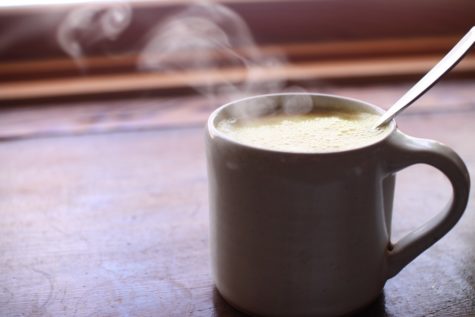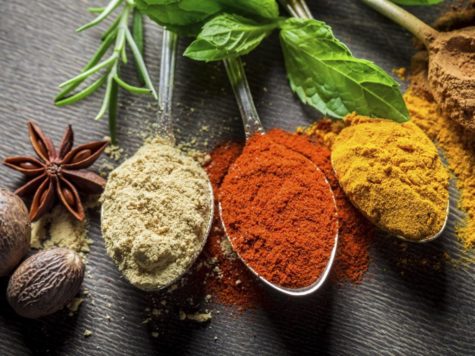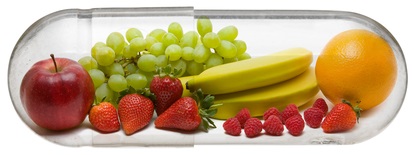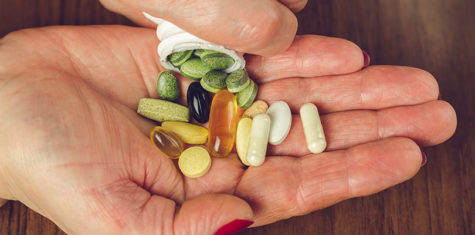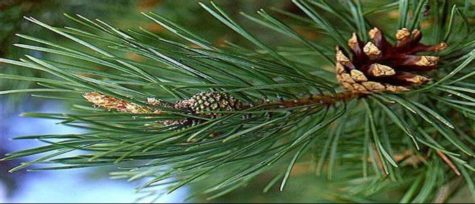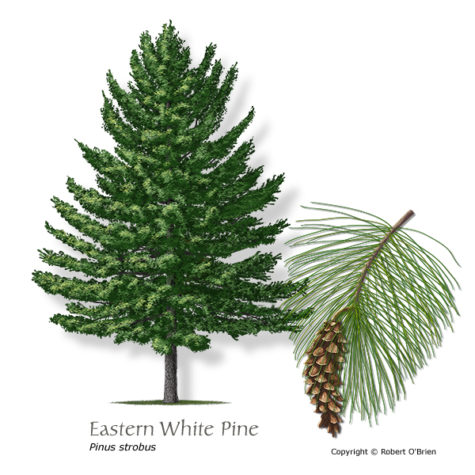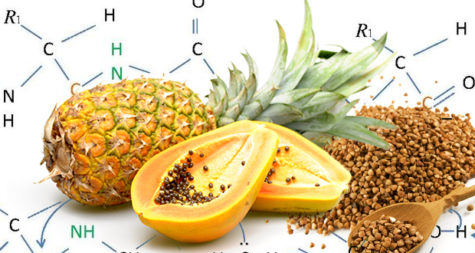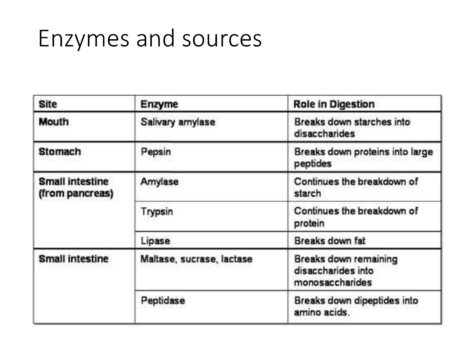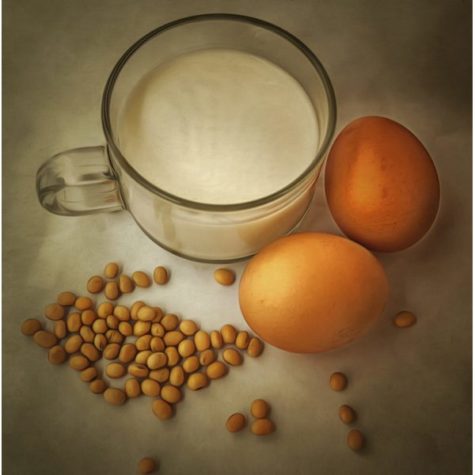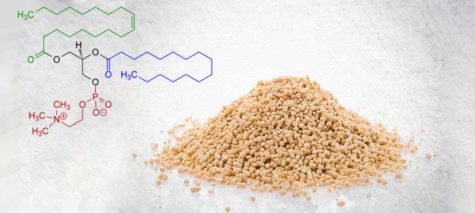Vitamins
Hot Milk Before Bed
A cup of hot milk before bed sets the stage for smooth transition into sleep. It soothes the nerves and, if you prepare it just right, it is tasty and full of nutrients. According to AyurVeda, milk is balancing to vata and pitta doshas.
Here’s a recipe to make your own delicious treat:
Boil the milk. Watch milk carefully until it boils, then let it continue to boil on low for about 5-10 minutes. Add spices (if desired).
- Turmeric reduces inflammation.
- Cardamom aids in digestion and adds sweetness.
- Cinnamon and ginger stimulate digestion and add a spicy kick.
- Vanilla flavor is also a delicious choice.
Pour the milk into your mug or cup of choice. Let sit until no longer scalding.
Optional:
After the milk cools completely, a teaspoon of honey or maple syrup can be added for sweetness. You can also add a half teaspoon of ghee (clarified butter).
Drink your milk and enjoy!
Note:
Milk does increase kapha dosha, which can cause weight gain, but this effect is lessened by using 2% or skim milk in place of whole milk. Hot milk pacifies vata dosha in the body and mind, allowing one to settle down for sleep.
In addition to these ayurvedic benefits, milk also supplies:
- Calcium, which keeps bones and teeth healthy and helps your body maintain bone mass
- Protein, a good source of energy that builds and repairs your muscle tissue
- Potassium, which helps maintain good blood pressure
- Phosphorus:, which strengthens your bones and gives you energy
- Vitamin D, which maintains bone density
- Vitamin B12, which maintains healthy red blood cells and nerve tissue
- Vitamin A which maintains the immune system, normal vision and good skin
- Niacin, which improves metabolism
Tonight, try boiling a cup of milk and feel the benefits for yourself. It may take a few tries to find the exact balance of spices you enjoy, but once you discover your favorites you will have a tasty new way to unwind in the evenings.
The Vitamins and Minerals in Your Spice Rack
Did you know that the spices you add to your food not only give a nice flavor boost, they also add nutrition? It was a surprise to me too. Here’s a cool list! The spices listed first, and shown in red, indicate there are large amounts of that nutrient in that particular spice. Interestingly, Black pepper, Cayenne, Ginger, and Turmeric are high on almost every list!
Vitamin A
- Black pepper, Cayenne, Chili, Cloves, Ginger, Mustard seed, Turmeric
- Allspice, Anise, Basil, Caraway Seed, Chervil, Chives, Cumin, Curry, Dill, Fennel, Fenugreek, Marjoram, Nutmeg, Oregano, Paprika, Parsley, Peppermint, Rosemary, Sage, Savory, Saffron, Tarragon, Thyme
B1 – Thiamine
- Mustard seed
B2 – Riboflavin
- Chili
- Paprika
B3 – Niacin
- Black pepper, Cayenne, Cinnamon, Chili, Ginger, Mustard seed, Turmeric
- Allspice, Anise, Caraway Seed, Chervil, Coriander, Cumin, Curry, Dill, Fennel, Fenugreek, Garlic, Marjoram, Nutmeg, Oregano, Paprika, Parsley, Peppermint, Sage, Savory
B5 – Pantothenic Acid
- Anise, Paprika
B6 – Pyridoxine
- Cayenne, Chili, Turmeric
- Curry, Dill, Fenugreek, Garlic, Paprika, Rosemary, Sage, Savory
B9 – Folic acid
- Black pepper, Cayenne, Cinnamon, Chili, Ginger, Mustard seed, Turmeric
- Allspice, Anise, Basil, Caraway Seed, Chervil, Chives, Cumin, Curry, Fenugreek, Garlic, Marjoram, Nutmeg, Oregano, Paprika, Parsley, Peppermint, Rosemary, Saffron, Sage, Tarragon, Thyme
Betaine
- Black pepper, Cinnamon, Chili, Ginger, Mustard seed, Turmeric
- Basil, Curry, Garlic, Oregano, Paprika
Vitamin C
- Black pepper, Cayenne, Cinnamon, Chili, Cloves, Ginger, Mustard seed, Turmeric
- Allspice, Anise, Basil, Caraway Seed, Chervil, Chives, Coriander, Curry, Cumin, Dill, Fennel, Fenugreek, Garlic, Marjoram, Nutmeg, Oregano, Paprika, Parsley, Peppermint, Rosemary, Saffron, Sage, Savory, Tarragon, Thyme
Calcium
- Black pepper, Cayenne, Cinnamon, Chili, Cloves, Ginger, Mustard seed, Turmeric
- Allspice, Anise, Basil, Cardamom, Chervil, Chives, Coriander, Cumin, Curry, Dill, Fennel, Garlic, Marjoram, Nutmeg, Oregano, Paprika, Parsley, Peppermint, Rosemary, Saffron, Sage, Salt, Savory, Tarragon, Thyme
Choline
- Black pepper, Cayenne, Cinnamon, Chili, Ginger, Mustard seed, Turmeric
- Basil, Caraway Seed, Chives, Cumin, Curry, Garlic, Marjoram, Nutmeg, Oregano, Paprika, Parsley, Sage, Thyme,
Copper
- Black pepper, Ginger
- Anise, Cardamom, Cumin, Curry, Fennel, Fenugreek, Nutmeg, Salt
Vitamin E
- Cayenne, Cinnamon, Chili, Ginger, Mustard seed, Turmeric
- Caraway Seed, Cumin, Curry, Garlic, Oregano, Paprika, Parsley, Sage, Thyme
Dietary Fiber
- Black pepper, Cayenne, Chili, Turmeric
- Allspice, Anise, Basil, Caraway Seed, Chervil, Chives, Coriander, Cumin, Curry, Dill, Fennel, Fenugreek, Garlic, Marjoram, Nutmeg, Oregano, Paprika, Parsley, Peppermint, Rosemary, Saffron, Sage, Savory, Tarragon, Thyme
Fluoride
- Black pepper
- Salt
Iron
- Black pepper, Cayenne, Cinnamon, Chili, Ginger, Mustard seed, Turmeric
- Allspice, Anise, Basil, Cardamom, Chervil, Coriander, Cumin, Curry, Dill, Fennel, Fenugreek, Garlic, Marjoram, Nutmeg, Oregano, Peppermint, Paprika, Parsley, Rosemary, Saffron, Sage, Salt, Savory, Tarragon, Thyme
Vitamin K
- Black pepper, Cayenne, Cinnamon, Chili, Mustard seed, Turmeric
- Basil, Chives, Cumin, Curry, Marjoram, Oregano, Paprika, Parsley, Sage, Thyme
Magnesium
- Black pepper, Cayenne, Cinnamon, Chili, Cloves, Ginger, Mustard seed, Turmeric
- Allspice, Anise, Basil, Caraway Seeds, Chervil, Chives, Coriander, Cumin, Curry, Dill, Fennel, Fenugreek, Garlic, Marjoram, Nutmeg, Oregano, Paprika, Parsley, Peppermint, Rosemary, Saffron, Sage, Salt, Savory, Tarragon, Thyme
Manganese
- Black pepper, Cayenne, Cinnamon, Chili, Ginger, Mustard seed, Turmeric
- Allspice, Anise, Caraway Seed, Coriander, Cumin, Curry, Dill, Fennel, Fenugreek, Marjoram, Nutmeg, Paprika, Parsley, Rosemary, Saffron, Sage, Salt, Savory, Thyme
Omega 3 – Fatty Acids
- Black pepper, Cayenne, Chili, Cinnamon, Ginger, Mustard seed, Turmeric
- Allspice, Basil, Caraway Seed, Chives, Cumin, Curry, Garlic, Marjoram, Oregano, Paprika, Peppermint, Rosemary, Saffron, Sage, Tarragon, Thyme
Omega 6 – Fatty Acids
- Black pepper, Cayenne, Chili, Cinnamon, Ginger, Turmeric
- Allspice, Anise, Basil, Caraway Seed, Chervil, Chives, Coriander, Cumin, Curry, Fennel, Garlic, Marjoram, Nutmeg, Oregano, Paprika, Parsley, Peppermint, Rosemary, Saffron, Sage, Tarragon, Thyme
Phosphorus
- Black pepper, Cayenne, Chili, Cinnamon, Ginger, Mustard seed, Turmeric
- Allspice, Anise, Basil, Caraway Seed, Chervil, Chives, Coriander, Cumin, Curry, Dill, Fennel, Fenugreek, Garlic, Marjoram, Nutmeg, Oregano, Paprika, Parsley, Peppermint, Rosemary, Saffron, Sage, Savory, Tarragon, Thyme
Phytosterols
- Black pepper, Cayenne, Chili, Cinnamon, Ginger, Mustard seed, Turmeric
- Allspice, Basil, Caraway Seed, Chives, Coriander, Cumin, Curry, Fennel, Fenugreek, Garlic, Marjoram, Nutmeg, Oregano, Paprika, Peppermint, Rosemary, Sage, Savory, Tarragon, Thyme
Potassium
- Black pepper, Cayenne, Cinnamon, Chili, Cloves, Ginger, Turmeric
- Allspice, Anise, Basil, Caraway Seed, Chervil, Chives, Coriander, Cumin, Curry, Dill, Fennel, Fenugreek, Garlic, Marjoram, Nutmeg, Oregano, Paprika, Parsley, Peppermint, Rosemary, Saffron, Sage, Savory, Tarragon, Thyme
Protein
- Black pepper, Cayenne, Chili, Ginger, Mustard seed, Turmeric
- Allspice, Anise, Basil, Caraway Seed, Chervil, Chives, Coriander, Cumin, Curry, Dill, Fennel, Fenugreek, Garlic, Marjoram, Nutmeg, Oregano, Paprika, Parsley, Peppermint, Rosemary, Saffron, Sage, Savory, Tarragon, Thyme
Selenium
- Black pepper, Cayenne, Chili, Cinnamon, Ginger, Mustard seed, Turmeric
- Allspice, Anise, Caraway Seed, Chervil, Coriander, Cumin, Curry, Fenugreek, Garlic, Marjoram, Nutmeg, Oregano, Paprika, Parsley, Rosemary, Saffron, Salt, Sage, Savory, Thyme
Sodium
- Black pepper, Cayenne, Chili, Cinnamon, Ginger, Turmeric
- Allspice, Anise, Basil, Caraway Seed, Chervil, Chives, Coriander, Cumin, Curry, Dill, Fennel, Fenugreek, Garlic, Marjoram, Nutmeg, Oregano, Paprika, Parsley, Peppermint, Rosemary, Saffron, Sage, Salt, Savory, Tarragon, Thyme
Zinc
- Black pepper, Cayenne, Chili, Cinnamon, Ginger, Turmeric
- Allspice, Anise, Caraway Seed, Chervil, Coriander, Cumin, Curry, Dill, Fennel, Fenugreek, Garlic, Marjoram, Nutmeg, Paprika, Parsley, Rosemary, Sage, Salt, Savory, Thyme
Source: Nutrition Data
About Minerals
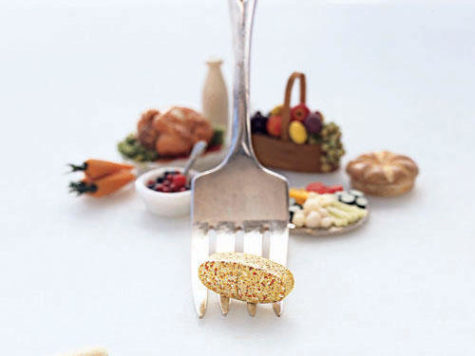 Minerals play an important role in every bodily function and are present in every human cell. Although the amount needed may be small, without even the trace of the mineral, dysfunction is bound to occur at some level in the body. A zinc deficiency may show up in ridged fingernails with white spots. Lack of sulfur can cause lack-luster hair and dull-looking skin. Less obvious deficiencies may surface as fatigue, irritability, loss of memory, nervousness, depression and weakness.
Minerals play an important role in every bodily function and are present in every human cell. Although the amount needed may be small, without even the trace of the mineral, dysfunction is bound to occur at some level in the body. A zinc deficiency may show up in ridged fingernails with white spots. Lack of sulfur can cause lack-luster hair and dull-looking skin. Less obvious deficiencies may surface as fatigue, irritability, loss of memory, nervousness, depression and weakness.
Minerals also interact with vitamins. Magnesium, for instance, must be present in the body for utilization of B-complex, C and E vitamins. Sulfur also works with the B-complex vitamins. The body needs all the trace minerals in proper balance.
Coffee, tea, alcohol, excess salt and many drugs can rob the body of minerals or make them ineffective. Industrial pollutants cause toxic minerals to enter the body. Minerals at toxic levels also have the effect of destroying the usefulness of other vitamins and minerals.
Exercise improves the activity of certain vitamins and minerals while stress and fatigue work against them. A well-balanced diet provides as abundance of minerals and vitamins. In refining cereals, grains and sugar, we have robbed them of their natural vitamins and minerals.
The dietary sources of these nutrients are whole grains, cereals, bran and germ. It is the bran and germ which are removed in processing. To obtain a balance of nutrients, it is, therefore, necessary to avoid refined and processed foods but an intake of adequate green leafy vegetables which are an excellent source of many nutrients should be ensured.
The mineral elements which are needed by the body in substantial amounts are calcium, phosphorous, iron, sulfur, magnesium, sodium, potassium and chlorine. In addition the body needs minute (trace) amounts of iodine, copper, cobalt, manganese, zinc, selenium, silicon, fluorine and some others.
The various functions of common minerals, their deficiency symptoms, and natural sources are discussed in brief as follows:
-
Calcium
The human body needs calcium more than any other mineral. A man weighing 70 kg. contains one kg. of calcium. About 99 per cent of the quantity in the body is used for building strong bones and teeth and the remaining one per cent is used by the blood, muscles and nerves.
Calcium performs many important functions. Without this mineral , the contractions of the heart would be faulty, the muscles would not contract properly to make the limbs move and blood would not clot. Calcium stimulates enzymes in the digestive process and coordinates the functions of all other minerals in the body.
Calcium is found in milk and milk products, whole wheat, leafy vegetables such as lettuce, spinach, and cabbage , carrots, watercress, oranges, lemons, almonds, figs and walnuts. Deficiency may cause porous and fragile bones, tooth decay, heart palpitations, muscle cramps, insomnia and irritability.
-
Phosphorus
It combines with calcium to create the calcium-phorphorus balance necessary for the growth of bones and teeth and in the formation of nerve cells. This mineral is also essential for the assimilation of carbohydrates and fats. It is a stimulant to the nerves and brain.
Phosphorous is found in abundance in cereals, pulses, nuts, egg yolk, fruit juices, milk and legumes. A phosphorous deficiency may bring about loss of weight, retarded growth, reduced sexual powers and general weakness. It may result in poor mineralization of bones, deficient nerve and brain function.
-
Iron
Iron is an important mineral which enters into the vital activity of the blood and glands. Iron exists chiefly as hemoglobin in the blood. It distributes the oxygen inhaled into the lungs to all the cells. It is the master mineral which creates warms, vitality and stamina. It is required for the healthy complexion and for building up resistance in the body.
The chief sources of iron are grapes, raisins, spinach, all green vegetables, whole grain, cereals, dried beans, dark colored fruits, beets, dates, liver and egg yolk.
Deficiency of dietary iron may cause nutritional-anemia, lowered resistance to disease, a general run down condition, pale complexion, shortness of breath on manual exertion and loss of interest in sex.
-
Sulphur
All living matter contains some sulphur; this element is therefore essential for life. The greater part of the sulphur in the human body is present in the two sulphur-containing amino acids, methionine and cysteine, or in the double form of the latter cystine.
The main purpose of sulphur is to dissolve waste materials. It helps to eject some of the waste and poisons from the system. It helps keep the skin clear of blemishes and makes hair glossy. It is also valuable in rheumatic conditions.
The main sulphur-containing foods are radishes, carrots, cabbage, cheese, dried beans, fish and eggs. A diet sufficient in protein will generally be adequate in sulphur. Deficiency of sulphur may cause eczema and imperfect development of hair and nails.
-
Magnesium
All human tissues contain small amounts of magnesium. Next to potassium, magnesium is the predominant metallic action in living cells. The bones seem to provide a reserve supply of this mineral in case of shortage elsewhere in the body. Biochemists call magnesium the “cool, alkaline, refreshing, sleep-promoting mineral”. Magnesium helps one keep calm and cool during the sweltering summer months. It aids in keeping nerves relaxed and normally balanced. It is necessary for all muscular activity.
This mineral is in activator for most of the enzyme system involving carbohydrate, fat and protein in energy-producing reactions. Magnesium promotes a healthier cardiovascular system and aids in fighting depression. It helps prevent calcium deposits in kidneys and gallstones and also brings relief from indigestion.
Magnesium is widely distributed in foods. It is a part of the chlorophyll in green vegetables. Other good sources of this mineral are nuts, soy beans, alfalfa, apples, figs, lemons, peaches, almonds, whole grains, brown rice, sunflower seeds and sesame seeds.
Deficiency can lead to kidney damage and kidney stones, muscle cramps, arteriosclerosis, heart attack, epileptic seizures, nervous irritability, marked depression and confusion, impaired protein metabolism and premature wrinkles.
-
Sodium
Sodium Chloride , the chemical name for common salt, contains 39 per cent of sodium, an element which never occurs in free form in nature. It is found in an associated form with many minerals especially in plentiful amounts with chlorine. Sodium is the most abundant chemical in the extra-cellular fluid of the body. It acts with other electrolytes, especially potassium, in the intracellular fluid, to regulate the osmotic pressure and maintain a proper water balance within the body. It is a major factor in maintaining acid-base equilibrium, in transmitting nerve impulses, and in relaxing muscles. It is also required for glucose absorption and for the transport of other nutrients across cell membranes.
There is some natural salt in every food we eat. Vegetable foods rich in sodium are celery, cucumbers, watermelon, lemons, oranges, grapefruit, beet-tops, cabbage, lettuce, corn, lady’s fingers, apple, berries, pears, squash, pumpkin, peaches, lentils, almonds and walnuts. Animal food sources include shell fish, lean beef, kidney, bacon and cheese.
Both deficiency and excess of salt may produce adverse effects on the human body. Deficiencies of sodium are, however, rare and may be caused by excessive sweating, prolonged use of diuretics, or chronic diarrhea. Deficiency may lead to nausea, muscular weakness, heat exhaustion, mental apathy and respiratory failure.
Over-supply of sodium is a more common problem because of overuse of dietary sodium chloride or common salt. Too much sodium may lead to water retention, high blood pressure, stomach ulcers, stomach cancer, hardening of arteries and heart disease.
-
Potassium
Potassium is essential to the life of every cell of a living being and is among the most generously and widely distributed of all the tissue minerals. Potassium is important as an alkalizing agent in keeping a proper acid-alkaline balance in the blood and tissues. It is essential for muscle contraction and therefore, important for proper heart function. It promotes the secretion of hormones and helps the kidneys in detoxification of blood. Potassium prevents female disorders by stimulating the endocrine hormone production. It is involved in the proper functioning of the nervous system and helps overcome fatigue. It also aids in clear thinking by sending oxygen to the brain and assists in reducing blood pressure.
Potassium is widely distributed in foods. All vegetables, especially green, leafy vegetables, grapes, oranges, lemons, raisins, whole grains, lentils, sunflower seeds, nuts, milk, cottage cheese and butter milk are rich sources. Potatoes, especial potato peelings, and bananas are especially good sources.
Potassium deficiency may occur during gastrointestinal disturbances with severe vomiting and diarrhea, diabetic acidosis and potassium-losing nephritis. It causes undue nervous and body tiredness, palpitation of the heart, cloudiness of the mind, nervous shaking of the hands and feet, great sensitivity of the nerves to cold, and excessive perspiration of the feet and hands.
-
Chlorine
This food element is necessary for the manufacture of glandular hormone secretions. It prevents the building of excessive fat and auto-intoxication. Chlorine regulates the blood’s alkaline -acid balance and works with Potassium in a compound form. It aids in the cleaning out of body waste by helping the liver to function.
Chlorine is found in cheese and other milk products, green leafy vegetables, tomatoes, all berries, rice, radishes, lentils, coconuts and egg yolk. Deficiency of this mineral can cause loss of hair and teeth.
-
Iodine
The chief store-house of iodine in the body is the thyroid gland. The essential thyroxine, which is secreted by this gland, is made by the circulating iodine. Thyroxine is a wonder chemical which controls the basic metabolism and oxygen consumption of tissues. It increases the heart rate as well as urinary calcium excretion. Iodine regulates the rate of energy production and body weight and promotes proper growth. It improves mental alacrity and promotes healthy hair, nails, skin and teeth.
The best dietary sources of iodine are kelp and other seaweeds. Other good sources are turnip greens, garlic, watercress, pineapples, pears, artichokes, citrus fruits, egg yolk and seafood and fish liver oils. Deficiency can cause goiter and enlargement of the thyroid glands.
-
Copper
This mineral helps in the conversion of iron into hemoglobin. It stimulates the growth of red blood cells. It is also an integral part of certain digestive enzymes. It makes the amino acid tyrosine usable, enabling it to work as the pigmentation factor for hair and skin. It is also essential for the utilization of vitamin C.
Copper is found in most foods containing iron, especially in almonds, dried beans, peas, lentils, whole wheat, prunes and egg yolk. A copper deficiency may result in bodily weakness, digestive disturbances and impaired respiration.
-
Cobalt
Cobalt is a component of vitamin B12, a nutritional factor necessary for the formation of red blood cells. Recent research in vitamin B12 has shown that its pink color is attributed to the presence of cobalt in it. The presence of this mineral in foods helps the synthesis of hemoglobin and the absorption of food-iron.
The best dietary sources of cobalt are meat, kidney and liver. All green leafy vegetables contain some amount of this mineral.
-
Manganese
This mineral helps nourish the nerves and brain and aids in the coordination of nerve impulses and muscular actions. It helps eliminate fatigue and reduces nervous irritability.
Manganese is found in citrus fruits, the outer covering of nuts, grains, in the green leaves of edible plants, fish and raw egg yolk. A deficiency of this mineral can lead to dizziness, poor elasticity in the muscles, confused thinking and poor memory.
-
Zinc
Our need for this mineral is small but its role in growth and well-being is enormous, starting before birth. It is needed for healthy skin and hair, proper healing of wounds, successful pregnancies and male virility. It plays a vital role in guarding against diseases and infection. It is needed to transport vitamin A to the retina. There are 156 enzymes that require zinc for their functioning. It has long been known that growth and sexual maturity depend on zinc.
The main dietary sources of zinc are milk, liver, beans, meat, whole grains, nuts, and seeds. Deficiency can result in weight loss, skin diseases, loss of hair, poor appetite, diarrhea and frequent infection. Those suffering from rheumatoid arthritis may have a zinc deficiency. Heavy drinkers lose a lot of zinc in their urine.
-
Selenium
Selenium and vitamin E are synergistic and the two together are stronger than the sum of the equal parts. Selenium slows down ageing and hardening of tissues through oxidation. Males seem to have a greater need for this mineral.
Selenium is useful in keeping youthful elasticity in tissues. It alleviates hot flushes and menopausal distress. It also helps in the prevention and treatment of dandruff.
This mineral is found in Brewer’s yeast, garlic, onions, tomatoes, eggs, milk and sea food. Deficiency of this mineral can cause premature loss of stamina.
-
Silicon
This is known as the ” beauty mineral ” as it is essential for the growth of skin, hair shafts, nails and other outer coverings of the body. It also makes the eyes bright and assists in hardening the enamel of the teeth. It is beneficial in all healing process and protects body against many diseases such as tuberculosis, irritations in mucous membranes and skin disorders.
Silicon is found in apples, cherries, grapes, asparagus, beets, onions, almonds, honey, peanuts and the juices of the green leaves of most other vegetables. Deficiency can lead to soft brittle nails, ageing symptoms of skin such as wrinkles, thinning or loss of hair, poor bone development, insomnia, osteoporosis.
-
Flourine
Fluorine is the element that prevents diseases from decaying the body. It is a germicide, and acts as an antidote to poison, sickness and disease. There is a strong affinity between calcium and fluorine. These two elements, when combined, work particularly in the outer parts of bones. They are found in the enamel of the teeth and the shiny, highly polished bone surface.
Fluorine is found in goat’s milk, cauliflower, watercress, garlic, beets, cabbage, spinach and pistachio nuts.
Source:
This information came from A Complete Handbook of Nature Cure, a complete handbook of Naturapathic Medicine. For more in depth information on vitamins, and vitamin therapy visit this post, The Importance of Minerals, over at Alternative Therapies.
About Vitamins
Vitamins are potent organic compounds which are found in small concentrations in foods. They perform specific and vital functions in the body chemistry. They are like electric sparks which help to run human motors. Except for a few exceptions, they cannot be manufactured or synthesized by the organism and their absence or improper absorption results in specific deficiency disease.
Vitamins A, D, E and K are all soluble in fat and fat solvents and are therefore, known as fat-soluble. They are not easily lost by ordinary cooking methods and they can be stored in the body to some extent, mostly in the liver. They are measured in international units.
Vitamin B Complex and C are water soluble. They are dissolved easily in cooking water. A portion of these vitamins may actually be destroyed by heating. They cannot be stored in body and hence they have to be taken daily in foods. Any extra quantity taken in any one day is eliminated as waste. Their values are given in milligrams and micrograms, whichever is appropriate.
The various functions of common vitamins, their deficiency symptoms, and natural sources are discussed in brief as follows:
Vitamin A
Known as anti-opathalmic, vitamin A is essential for growth and vitality. It builds up resistance to respiratory and other infections and works mainly on the eyes, lungs, stomach and intestines. It prevents eye diseases and plays a vital role in nourishing the skin and hair. It helps to prevent premature ageing and senility, increases life expectancy and extends youthfulness.
The main sources of this vitamin are fish liver oil, liver, whole milk, curds, pure ghee, butter, cheese, cream and egg yolk, green leafy and certain yellow root vegetables such as spinach, lettuce, turnip, beets, carrot, cabbage and tomato and ripe fruits such as prunes, mangoes, papaya, apricots, peaches, almonds and other dry fruits.
A prolonged deficiency of vitamin A may result in inflammation of the eyes, poor vision frequent colds, night blindness and increased susceptibility to infections, lack of appetite and vigor, defective teeth and gums and skin disorders.
B Complex Vitamins
There are a large variety of vitamins in the B group, the more important being B1 or thiamine, B2 or riboflavin, B3 or niacin or nicotinic acid, B6 or pyridoxine, B9 or folic acid, B12 and B5 or pantothenic acid. B vitamins are synergistic. They are more potent together than when used separately.
- Thiamine
Known as anti-beberi, anti-neuritic and anti-ageing vitamin, thiamine plays an important role in the normal functioning of the nervous system, the regulation of carbohydrates and good digestion. It protects heart muscle, stimulates brain action and helps prevent constipation. It has a mild diuretic effect.
Valuable sources of this vitamin are wheat germ, yeast, the outer layer of whole grains, cereals, pulses,nuts, peas, legumes, dark green leafy vegetables, milk, egg,banana and apple.
The deficiency of thiamine can cause serious impairment of the digestive system and chronic constipation, loss of weight, diabetes, mental depression, nervous exhaustion and weakness of the heart.
- Riboflavin
Vitamin B2 or riboflavin, also known as vitamin G, is essential for growth and general health as also for healthy eyes, skin, nails and hair. It helps eliminate sore mouth, lips and tongue. It also functions with other substances to metabolize carbohydrates, fats, and protein.
The main sources of this vitamin are green leafy vegetables, milk, cheese, wheat germ, egg, almonds, sunflower, seeds, citrus fruits and tomatoes.
Its deficiency can cause a burning sensation in the legs, lips and tongue, oily skin, premature wrinkles on face and arm and eczema.
- Niacin
Vitamin B3 or niacin or nicotinic acid is essential for proper circulation, healthy functioning of the nervous system and proper protein and carbohydrate metabolism. It is essential for synthesis of sex hormones, cartisone, thyroxin and insulin. It is contained in liver, fish, poultry, peanut, whole wheat,green leafy vegetables, dates, figs, prunes and tomato.
A deficiency can lead to skin eruptions, frequent stools, mental depression, insomnia, chronic headaches, digestive disorders and anemia.
- Pyridoxine
Vitamin B 6 or pyridoxine is actually a group of substance – pyridoxine, pyridoxinal and pyridoxamine – that are closely related and function together. It helps in the absorption of fats and proteins, prevents nervous and skin disorders and protects against degenerative diseases.
The main sources of this vitamin are yeast, wheat, bran, wheat germ, pulses, cereals, banana, walnuts, soy beans, milk, egg, liver, meat and fresh vegetables.
Deficiency can lead to dermatitis, conjunctivitis, anemia, depression, skin disorders, nervousness, insomnia, migraine headaches and heart disease.
- Folic Acid
Vitamin B9 or folic acid, along with vitamin B12 is necessary for the formation of red blood cells. It is essential for the growth and division of all body cells for healing processes. It aids protein metabolism and helps prevent premature graying.
Valuable sources of this vitamin are deep green leafy vegetables such as spinach, lettuce, brewers yeast, mushrooms, nuts, peanuts and liver.
A deficiency can result in certain types of anemia, serious skin disorders, loss of hair, impaired circulation, fatigue and mental depression.
- Pantothenic Acid
Vitamin B5 or pantothenic acid helps in cell building, maintaining normal growth and development of the central nervous system. It stimulates the adrenal glands and increases the production of cortisone and other adrenal hormones. It is essential for conversion of fatty and sugar to energy. It also helps guard against most physical and mental stresses and toxins and increases vitality.
The main sources of this vitamin are whole grain bread and cereals, green vegetables, peas, beans, peanuts and egg yolk. It can be synthesized in the body by intestinal bacteria.
A deficiency can cause chronic fatigue, hypoglycemia, graying and loss of hair, mental depression, stomach disorders, blood and skin disorders.
- Vitamin B12
Vitamin B12 or cobolamin, commonly known as “red vitamin” , is the only vitamin that contains essential mineral elements. It is essential for proper functioning of the central nervous system, production and regeneration of red blood cells and proper utilization of fat, carbohydrates and protein for body building. It also improves concentration, memory and balance.
Valuable sources of this vitamin are kidney, liver, meat, milk, eggs, bananas and peanuts. Its deficiency can lead to certain types of anemia, poor appetite and loss of energy and mental disorders.
- Vitamin C
Vitamin C or ascorbic acid is essential for normal growth and the maintenance of practically all the body tissues, especially those of the joints, bones, teeth, and gums. It protects one against infections and acts as a harmless antibiotic. It promotes healing and serves as protection against all forms of stress and harmful effects of toxic chemicals. It helps prevent and cure the common cold. It also helps in decreasing blood cholesterol.
This vitamin is found in citrus fruits, berries, green and leafy vegetables, tomatoes, potatoes, sprouted sprouted bengal (a variety of chickpea) and green grams (mung beans).
A deficiency can cause scurvy marked by weakness, anemia, bleeding gums and painful and swollen parts, slow healing of sores and wounds, premature ageing and lowered resistance to all infections.
- Vitamin D
Vitamin D is necessary for proper bone and teeth formation and for the healthy functioning of the thyroid gland. It assists in the assimilation of calcium, phosphorus and other minerals from the digestive tract.
This vitamin is found in the rays of the sun, fish, milk, eggs, butter and sprouted seeds. A deficiency can cause gross deformation of bones and severe tooth decay.
- Vitamin E
Vitamin E is essential for normal reproductive functions, fertility and physical vigor. It prevents unsaturated fatty acids, sex hormones and fat soluble vitamins from being destroyed in the body by oxygen. It dilutes blood vessels and improves circulation. It is essential for the prevention of heart diseases, asthma, arthritis, and many other conditions.
It is available in wheat or cereals germ, whole grain products, green leafy vegetables, milk, eggs, all whole, raw or sprouted seeds and nuts.
Its deficiency can lead to sterility in men and repeated abortions in women, degenerative developments in the coronary system, strokes and heart disease.
- Vitamin K
Vitamin K is necessary for the proper clotting of blood, prevention of bleeding and normal liver functions. It aids in reducing excessive menstrual flow.
This vitamin is contained in egg yolk, cow’s milk, yogurt, alfalfa, green and leafy vegetables, spinach, cauliflower, cabbage and tomato. Its deficiency can lead to sufficient bile salts in the intestines, colitis, lowered vitality and premature ageing.
Source:
This information came from A Complete Handbook of Nature Cure, a complete handbook of Naturapathic Medicine. For more in depth information on vitamins, and vitamin therapy visit this post, The Importance of Vitamins, over at Alternative Therapies.
Pine Needles ~ Benefits and Nutrients
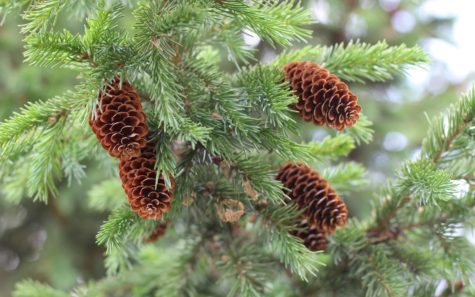
Pine needles range in size from 3 to 5 inches and are a deep forest green color. The long, thin needles vary slightly from variety to variety, depending on the region in which they grow. Pine needles have a strong pine scent, and a biting resinous flavor. In the wild Pine needles can be foraged year-round.
Foraged Pine needles can be used for a variety of applications. Pine needles are used most often for the oils and aroma within, to impart a pine scent or flavor to teas, ice creams, and liquors. Pine needles can be used like applewood or mahogany in fires to smoke meats or chicken, adding a hint of pine flavor. Place Pine needles under fish while cooking or chop like rosemary and add to marinades or brine. A variety of recipes can be found here.
Nutritional Value
It is said that Pine needles can be used as a natural remedy for up to 80% of human diseases. Pine needles are high in vitamin C; a tea made with the needles of the Pine tree has been used to stave off scurvy when no other sources of vitamin C were readily available. In a tincture or tea, Pine needles can help alleviate congestion and other respiratory problems. Components in Pine needles have decongestant, disinfectant and wound healing properties.
- Vitamin C Content
Pine needles purportedly have three to five times more vitamin C than an orange, depending on what source you read, but there’s no hard and fast rule for how much C is in a pine needle.
Regardless of the exact percentage, we know that pine needles and pine bark make an excellent natural vitamin C supplement. At least they’re potent enough to cure scurvy, a chronic condition caused by vitamin C deficiency that, left untreated, results in death.
One historical account relates the 1536 story of French explorer Jacques Cartier, whose crew was cured of scurvy with a tea of pine needles and bark given to them by the Iroquois after the crew suffered months of nutritional deprivation at sea.
Even though the crew boiled the decoction, which would have destroyed a significant portion of the vitamin C, there was still enough ascorbic acid and various amino acids to completely reverse their symptoms of scurvy.
It was such a dramatic change, the tree used for tea became known as “tree of life”. There’s no way to determine exactly what species it was, but we know the tree of life was a conifer. Eastern white pine is just one of the handful of candidates that could have been used.
The ascorbic acid (vitamin C) content of pine needles seems to vary significantly depending mainly on the species of pine and the age of the needles. The Eastern white pine needles of this USDA Forest Service study had between 0.72 mg and 1.87 mg of ascorbic acid per gram of pine needles.
New needles had the lower concentration, while 1 year old needles had 1.18 mg of vitamin C per gram of needles, and 2 year old needles had as much as 1.87 mg.
According to the USDA, 100 g of orange has 53.2 mg of vitamin C, or .532 mg/g. That puts pine needles at slightly more vitamin C for new needles, twice as much for 1 year old needles, and 3.5 times as much vitamin C for 2 year old needles.
The gist of the research is that ascorbic acid content increases with the age of the needles. Does that mean older needles are best for pine needle tea? Not if you’re after taste. Older needles make a stronger, bitter, more piney tasting tea, so if you want a milder, more delicate tea, look for brighter green young pine needles.
And don’t boil them. Boiling not only destroys vitamin C, but it also releases more terpenes–the organic compounds that make pine smell like pine–making more of a turpentine-like tea.
Other research indicates that balsam fir needles have significantly more vitamin C than white pine, so species matters, and the bark of white pine has more than needles. If you want a more potent brew of vitamin C, throw in some pine bark, although I can’t vouch for flavor, since I’ve never tried it.
Although there are several species of pine that make suitable tea, Eastern white pine (Pinus strobus) is one of the trees more commonly associated with pine needle tea, probably for its superior flavor.
Health Benefits of Pine
There have been a number of studies done on the nutritional qualities and healing powers of pine needles and bark. Here are just a few:
- Cancer prevention
(Antioxidant, antimutagenic, and antitumor effects of pine needles (Pinus desiflora)):
“These results demonstrate that pine needles exhibit strong antioxidant, antimutagenic, and antiproliferative effects on cancer cells and also antitumor effects in vivo and point to their potential usefulness in cancer prevention.”
- Cardiovascular health, antioxidant, immune function
(Comparison of methods for proanthocyanidin extraction from pine (densiflora) needles and biological activities of the extract):
“Flavonoids are known to be effective scavengers of free radicals. In particular, proanthocyanidins are flavonoids that possess cardiovascular protection, antioxidative activities, and immunomodulatory activities…In this study, we discerned an efficient extraction method to achieve relatively pure proanthocyanidins from pine needles and evaluated the biological functions of the resulting extract, which could potentially be used for its efficacious components in functional food products.”
- Potential treatment for anxiety, depression, and dementia
(Effect of new polyprenol drug ropren on anxiety-depressive-like behavior in rats with experimental Alzheimer disease):
“The obtained results…indicate that Ropren [a trademarked preparation based on extract of spruce and pine needles] is potentially active in the management of affective impairments in the experimental model under consideration. It also has a profound beneficial effect on the anxiety and depressive-like behavior in rats with model Alzheimer’s type dementia, and thus may prove to be a novel natural treatment.”
Dangers and Cautions:
Avoid pines that aren’t really pines. These include Yew pine (Podocarpus macrophylla) and Norfolk Island pine (Araucana heterophylla). And stay away from the highly toxic yew (genus Taxus).
Most sources warn of the potential dangers of pines like Ponderosa pine (Pinus ponderosa) and Lodgepole Pine (Pinus contorta), citing the possibility of abortion from drinking tea made with these species. And some sources say all pines could potentially cause abortion.
According to Green Deane Jordan of EatTheWeeds, pine needle tea drunk in moderation shouldn’t cause any problems unless you’re allergic to pine:
“The basis for this rumor is a veterinary study decades ago. If you are a cow and you eat many pounds of Ponderosa Pine needles you have a 5 to 8 percent chance out of 100 of having an abortion or still-birth. If you boil a huge amount of pine needles in water for hours down to a small amount of gross liquid and you drink it, then maybe it would cause an abortion. A few of needles soaked in hot water is no threat to anyone except for possible allergies.”
If you’re worried about it, stick with tried and true Eastern white pine, and of course exercise moderation.
Sources:
The Role of Enzymes in Nutrition
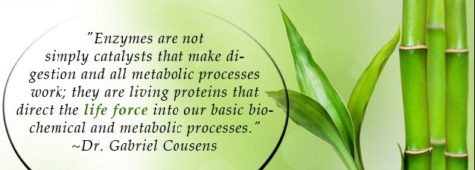
Enzymes are chemical substances produced in the living organism. They are marvelous organic catalysts which are essential to life as they control all the chemical reactions that take place in a living system. Enzymes are part of all living cells, including those of plants and animals. The term enzyme, which literally means in yeast’, was coined following the demonstration of catalytic properties of yeast and yeast juices.
Although enzymes are produced in the living cell, they are not dependent upon the vital processes of the cell and work outside the cell. Certain enzymes of yeast, for instance, when expressed from the yeast cells are capable of exerting their usual effect, that is, the conversion of sugar to alcohol.
A striking feature of enzymes is that while they enter into chemical reaction, they remain intact in the process. They however, act with maximum efficiency at a certain temperature. Lowering the temperature below or raising it above this level slows the reaction. A high degree of heat, that is above 60 o C, permanently destroys their action.
It has been estimated that there are over 20,000 enzymes in the human body. This estimate is based on the number of bodily processes that seem to require action. However, so far only about 1,000 enzymes have been identified. But their great role in nutrition and other living processes has been firmly established.
They are protein molecules made up of chains of amino acids. They play a vital role and work more efficiently than any reagent concocted by chemists. Thus for instance, a chemist can separate proteins into their component amino acids by boiling them at 166 o C for over 18 hours in a strong solution of hydrochloric acid, but the enzymes of the small intestines can do so in less than three hours at body temperature in a neutral medium.
A feature which distinguishes enzymes from inorganic catalysts is that they are absolutely specific in their actions. This means that a particular enzyme can cause reactions involving only a particular type of substance or a group of closely related substances. The substance on which the enzyme acts is known as “substrate”. The specificity of an enzyme is, however, related to the formation of the enzyme-substrate complex which requires that the appropriate groupings of both substrate and enzyme should be in correct relative position. The substrate must fit the enzyme like a key fits its lock.
Enzymes which are used in the cells which make them are called intracellular enzymes. Enzymes which are produced in cells which secrete them to other parts of the body are known as extracellular enzymes. Digestive juices are an example of the latter type.
Nomenclature
There are few enzymes whose names have been established by long usage such as ptyalin, pepsin, trypsin and erepsin. Apart from these, enzymes are usually named by adding the suffixes to the main part of the name of the substrate upon which they act. Thus amylases act upon starch (amylum), lactase acts upon lactose, lipases act upon lipids, maltase acts upon maltose and protesses act upon lipids, maltase acts upon maltose and protesses act upon proteins.
There are, however, several enzymes which act upon many substances in different ways. These enzymes are named by their functions rather than substrates. Thus, an enzyme which causes deaminations is called a deaminase and oxidizing enzyme an oxidase.
Some enzymes work efficiently only if some other specific substance is present in addition to substrate. This other substance is known as an “activator” or a “con-enzyme” . “Acti- vators” are usually inorganic ions. They increase the activity of a complete enzyme and may take part in the formation of the enzyme-substrate complex.
Many of the con-enzymes are related to vitamins. This explains why vitamin deficiencies profoundly alter metabolism. Thus, for instance, thiamine, as thiamine pyrophosphate, functions as a con-enzyme in at least 14 enzymes systems. Con-enzymes, like enzymes, are being continuously regenerated in the cells.
Enzymes play a decisive role in the digestion of food as they are responsible for the chemical changes which the food undergoes during digestion. The chemical changes comprise the breaking up of the large molecules of carbohydrates, fats and proteins into smaller ones or conversion of complex substances into simple ones which can be absorbed by the intestines. They also control the numerous reactions by which these simple substances are utilized in the body for building up new tissues and producing energy.
The enzymes themselves are not broken down or changed in the process. They remain as powerful at the end of a reaction as they were at the beginning. Moreover, very small amounts can convert large amounts of material. They are thus true catalysts.
The process of digestion begins in the mouth. The saliva in the moth, besides helping to masticate the food, carries an enzyme called ptyalin which begins the chemical action of digestion. It initiates the catabolism (breakdown) of carbohydrates by converting starches into simple sugars. This explains the need for thorough mastication of starchy food in the mouth. If this is not done the ptyalin cannot carry out its functions as it is active in an alkaline, neutral or slightly acid medium and is inactivated by the highly acid gastric juices in the stomach.
Although enzymatic action starts while food is being chewed, digestion moves into high gear only when the chewed food has passed the esophagus and reached the stomach. While the physical action of peristalsis churns and kneads solid food into a semi-solid amorphous mixture called chyme, this mixture undergoes chemical changes initiated by gastric juices secreted by the walls of the stomach. These juices include mucus for lubricating the stomach, hydrochloric acid and gastric juice.
The enzyme or active principle of the gastric juice is pepsin. This enzyme in combination with hydrochloric acid starts the breakdown of proteins into absorbable amino acids called polypeptides. An additional enzyme, rennin, plays an important role in the stomach of the infant. It curdles milk and allows the pepsin to work upon it. The gastric juice has no effect upon starches or fats. When the chyme leaves the stomach and enters the small intestine through the pylorus – the lower escape valve, it still contains much food which is in the form of raw material not yet ready for absorption in the body.
Digestion is completed inside the small intestine by several juices. From liver comes a liquid called bile which converts fat globules into a smooth emulsion. The pancreas contributes various enzymes which continue the breakdown of proteins, help to divide starch into sugars and work with bile in digesting fats. The small intestine itself secretes enzymes from its inner wall to complete the reactions.
When all the enzymes have done their work, the food is digested and rendered fit for absorption by the system.The following table briefly summarizes the chemical digestion of carbohydrates, fats and proteins by various enzymes:
Enzymes form part of the food we eat. Raw foods contain enzymes in abundance; cooking, pasteurizing, pickling, smoking and other processing denature enzymes. It is, therefore, essential to include in our diet, substantial amount of raw foods in the form of fruits, raw salads and sprouts. Studies have revealed that the body without sufficient raw materials from raw foods, may tire and produce fewer enzymes year after year. This may lead to wearing out of body processes and consequent worn-out looks.
Lecithin – An Amazing Youth Element
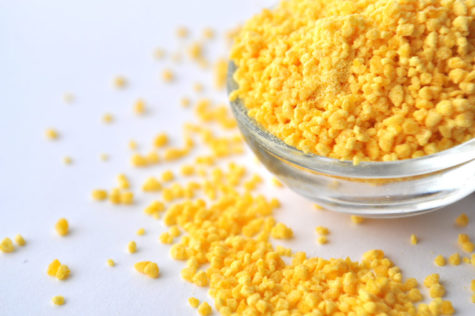
Lecithin is the most abundant of the phospholipids. It is a fatty food substance, which serves as a structural material for every cell in the body. It is an essential constituent of the human brain and nervous system. It forms 30 per cent of the dry weight of the brain and 17 per cent of the nervous system.
Lecithin is also an important component of the endocrine glands and the muscles of the heart and kidneys. It makes up 73 per cent of the total liver fat. Nervous, mental or glandular over activity can consume lecithin faster than its replacement. This may render a person irritable and exhausted. It is, therefore, of utmost importance to add lecithin to the diet, if the body’s own supply decreases as in old age or working under stress.
Rich Sources
Lecithin is derived from the Greek Word, likithos, meaning egg yolk. Egg yolk is a rich source of lecithin, and also a rich source of cholesterol. This combination makes it possible for the lecithin to emulsify the cholesterol. Vegetable oils, whole grain cereals, soy beans, liver and milk are other rich sources of lecithin.
The cells of the body are also capable of synthesizing it as needed, if several of the B vitamins are present. Since these B vitamins are generally removed when grains are refined, people who eat exclusively white flour products are lacking them.
Benefits
The action of lecithin on the heart is the most important of all its proved benefits. It achieved its popularity initially in this area. Cholesterol is a fatty substance that tends to collect in the walls of the arteries and veins, thus narrowing them. This may eventually lead to a fatal blood clot. Scientific studies have shown that lecithin has the ability to break up cholesterol into small particles which can be easily handled by the system. With sufficient intake of lecithin, cholesterol cannot build up against the walls of the arteries and veins.
Like cholesterol, lecithin is continuously produced in the liver, passes into the intestine with bile and is absorbed in the blood. It helps in the transportation of fats. It also helps the cells to remove fats and cholesterol from the blood and to utilize them. It increases the production of bile acids made from cholesterol, thereby reducing the amount in the blood. It will thus be seen that cholesterol can cause trouble only if lecithin is lacking in the system.
All atherosclerosis or changes in the arterial walls are characterized by an increased of the blood cholesterol and a decrease in lecithin. It has been shown that experimental heart disease, produced by feeding cholesterol, could be prevented merely by giving a small quantity of lecithin. Atherosclerosis has been produced in various species of animals by increasing the blood cholesterol or decreasing the lecithin.
In normal health, when a diet high in fat is taken, there is tremendous increase in the production of lecithin. This helps in changing the fat in the blood from large particles to smaller and smaller ones. In case of atherosclerosis, however, the lecithin in the blood remains very low regardless of the quantity of fat entering the blood. The result is that, the fat particles remain too large to be able to pass through the arterial walls.
A more serious situation can develop if there is lack of lecithin in cells also. Besides reducing the cholesterol level in the blood, there is mounting scientific evidence to suggest several other benefits from lecithin. It has been suggested that its intake in sufficient amounts can help rebuild those cells and organs which need it. Lecithin helps to maintain their health once they are repaired. It may mean that a deficiency of lecithin in the diet may be one of the causes of ageing and that its use may be beneficial in retarding the ageing process.
Edward R. Hewith in his book, The Years Between 75 and 90 says:
” with older people the fats remain high in the blood for from five to seven hours and in some cases as long as 20 hours, thus giving the fats more time to become located in the tissues. If lecithin is given to older people before a fatty meal, it has been found that the fats in the blood return to normal in a short time, in the same way they do in younger people.”
In some cases, the cosmetic effect of lecithin does as much for the mental outlook of persons as it does for their physical well-being. It has been found to eliminate the yellow or yellow- brown plaques on the skin or around the eyes caused by fatty deposits. It is a natural tranquilizer which is beneficial in nervous exhaustion. It can produce great alertness in elderly people.
Some studies have indicated that lecithin increases the gamma globulin in the blood. This helps fight infection. It provides an increased immunity against pneumonia. It has also been found to lower blood pressure in some people. In combination with vitamin E, it has proved helpful in lowering the requirements of insulin in diabetics. It has also proved valuable in the treatment of certain skin ailments, including acne, eczema and psoriasis.
Lecithin has been suggested as a sexual aid. It was used in Germany 30 years ago as a restorative of sexual powers, for glandular exhaustion and nervous and mental disorders. Seminal fluid is rich in lecithin. Because of its loss from the body, its need for men is regarded as specially great. Its use is also considered valuable in minimizing pre-menstrual and menopausal tension.
Dr. N.A. Ferri, an eminent physician remarks:
“Lecithin has a versatile function in life. It is an extremely important factor in the digestion and oxidation of fats, thus creating more muscle and glandular activity, resulting in greater body exertion and less fat accumulations.
Lecithin is essential not only for tissue integrity of the nervous and glandular system in all living cells, but has been regarded as also the most effective generator and regenerator of great physical, mental and glandular activity.
Shattered nerves, depleted brain power, waning activity of vital glands, find in lecithin, especially in the cellular structure of the nervous system and endocrine glands a source of dynamic energy.”
The best way to increase lecithin is to eat the same amount of fat as usual, but reduce animal fat except that from fish. Oil may be used for cooking, seasoning and salad dressing. All hydrogenated fats such as margarine, cooking fats, hydrogenated peanut butter and processed cheese should be avoided as also foods prepared with them.
